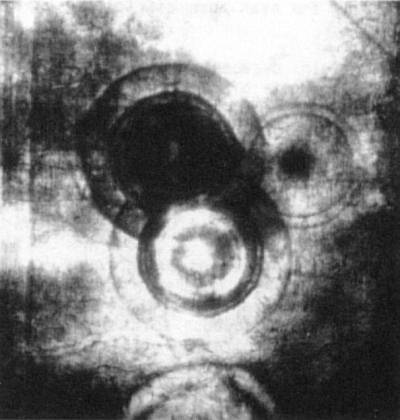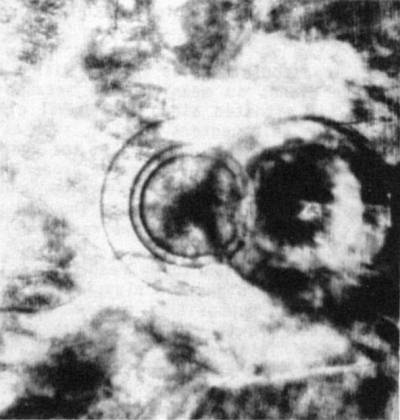| ESA | Return to https://www.halos.com/book/ctm-app-22-d.htm. | ESA |
< Prev T of C ... 12 13 14 15 Epi. Cat. App. Ref. Cred. Next >
Before discussing Brown's assertion about minerals of hydrothermal classification, I will discuss his evaluation of halos in mica, a mineral that is generally considered to be of this type. In his first paragraph Brown suggests, without any supporting evidence, that halo centers along conduits and cleavage planes in mica support a hydrothermal origin of halos in this mineral. (In other words, halos which developed from radioactivity captured out of a solution containing significant concentrations of radioactive elements.) This suggestion was [p. 315] initially made by some early investigators who worked on halos about a half a century ago. There were serious problems with this hypothesis then, and even more difficulties with it now.
First, to associate halos in mica with a hydrothermal origin because their centers are along cleavage planes is meaningless because the crystal structure of mica is such that every center is situated along some basal cleavage plane. Secondly, there are numerous uranium and thorium halo centers in mica, such as monazites and zircons, which are not considered to be of hydrothermal origin (in the conventional usage of that term). Thirdly, Brown fails to say that the perfect cleavage properties of mica provided me with the opportunity over 20 years ago of examining the microscopic distribution of alpha radioactivity around polonium halo centers, and those studies showed no evidence for a secondary origin of polonium halos in this mineral. In fact, the report describing those results is cited in my ICC paper.
I now turn attention to my respected colleague's comment about halos being found in earth minerals of hydrothermal classification. This comment is a clear reference to the standard uniformitarian supposition that many primary minerals formed over geological time by very slow crystal growth either in a magma containing water, or in aqueous solutions laden with the chemical elements of which the mineral is composed. Uniformitarian geologists adopted this belief long ago mainly because: (1) it is possible to use aqueous solutions to slowly grow crystals of some minerals in the laboratory, and (2) there was evidence that many secondary minerals in sedimentary deposits had formed in this fashion. Geologists merged these two observations together with the uniformitarian principle and went on to assume that the vast number of primary minerals found in the earth—here I refer to the minerals found in crystalline rocks such as the Precambrian granites and pegmatites—achieved their large size through a slow growth process.
In my recent book, Creation's Tiny Mystery, I challenge the assumption that large crystals of primary minerals grew from small crystals over evolutionary time, and in particular refer to the existence of polonium halos as unambiguous evidence that these minerals were created. I also note in my book that evolutionary geologists should long ago have seen the falsity of this supposition both from the huge size of some natural crystals and from their inability to synthesize even reasonable size specimens of certain minerals such as biotite, an iron-rich mica which often contains radiohalos.
Summarizing, the term "minerals of hydrothermal classification" does represent a correct description of origin when applied to secondary mineral formation in sedimentary deposits. On the other hand, it is incorrect when applied in the conventional geological sense to describe the origin of primary minerals. Thus, Brown's argument for a water-related origin of halos in those minerals is invalid because it is based on the erroneous assumption that primary (or primordial) minerals developed through slow crystal growth over geological time.
For further clarification of the preceding paragraph, I should emphasize that, as might be expected, in the context of my creation model certain terms have a different meaning. With this new meaning there may be a definite relation between primary minerals and "minerals of hydrothermal classification." In my book, Creation's Tiny Mystery, I referred to the creation of earth's primordial rocks in the context of an instantaneous crystallization of a primordial liquid. More precisely, I envision there were a variety of primordial liquids called into existence on Day 1 (and perhaps Day 3) which gave rise to various types of primordial rocks. In my opinion, 2 Peter 3:5 strongly suggests that these primordial liquids must have included water at some instant in time within the creation process. In this sense the primordial (primary) minerals created on Day 1 (and perhaps Day 3) of creation week could also be viewed as "minerals of hydrothermal classification."
Skipping over paragraph 2 momentarily, paragraph 3 expresses some of my colleague's philosophical views, and he is certainly entitled to those opinions. Moreover, any scientist has a right to formulate any hypothesis he chooses about creation, and he is entitled to use the data published in my reports in this endeavor. However, if my data are used, then that scientist should be careful to state just where his own assumptions are introduced into his interpretation of my data, and in addition, he should make it quite clear that the conclusions obtained with these different assumptions are separate and distinct from my views. Unfortunately, that distinction is not clear in several places in Brown's review of my ICC paper, hence the need for extensive clarification on my part. Paragraph 2 is one place where such clarification is essential.
Brown introduces his second paragraph by stating that the existence of well-developed uranium halos in association with polonium halos presents a problem for a view that limits the age of all minerals—or equivalently, the age of the earth—to less than 10,000 years. In Figure 1(a) and 1(b) I show two examples of the specific association of halos to which my colleague refers in the above statement. (Readers desiring further information about these halos should refer to the photos in my ICC paper.)
[p. 316]
Figure 1. Both (a) and (b) show a polonium-218 halo adjacent to an overexposed uranium halo in the Wolsendorf fluorite. (Scale is about 1 cm = 29 micrometers).

|
Doc.: T of C ... #18 #19 #20 #21 #22 #23 #24 #25 #26 ...
< Prev T of C ... 12 13 14 15 Epi. Cat. App. Ref. Cred. Next >
© 2004
Earth Science Associates

